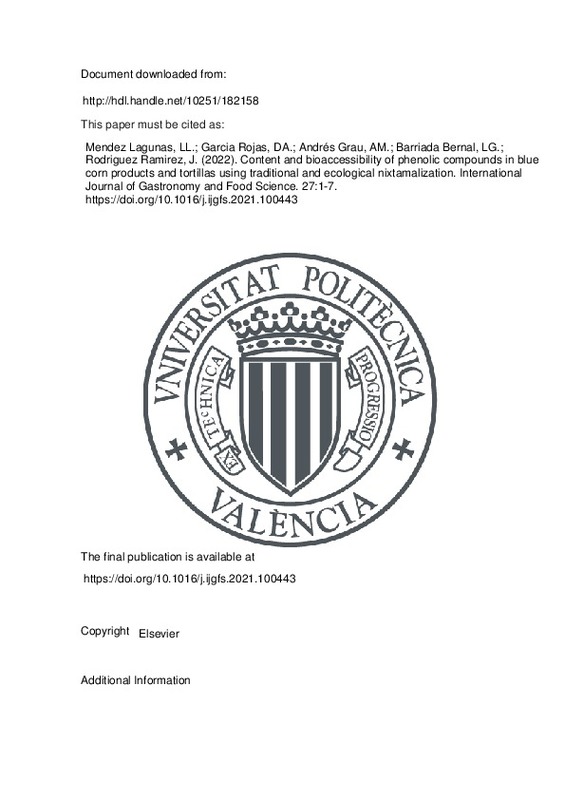JavaScript is disabled for your browser. Some features of this site may not work without it.
Buscar en RiuNet
Listar
Mi cuenta
Estadísticas
Ayuda RiuNet
Admin. UPV
Content and bioaccessibility of phenolic compounds in blue corn products and tortillas using traditional and ecological nixtamalization
Mostrar el registro sencillo del ítem
Ficheros en el ítem
| dc.contributor.author | Mendez Lagunas, Lilia L.
|
es_ES |
| dc.contributor.author | Garcia Rojas, Daniel Alberto
|
es_ES |
| dc.contributor.author | Andrés Grau, Ana María
|
es_ES |
| dc.contributor.author | Barriada Bernal, Luis Gerardo
|
es_ES |
| dc.contributor.author | Rodriguez Ramirez, Juan
|
es_ES |
| dc.date.accessioned | 2022-04-27T06:28:30Z | |
| dc.date.available | 2022-04-27T06:28:30Z | |
| dc.date.issued | 2022-03 | es_ES |
| dc.identifier.issn | 1878-450X | es_ES |
| dc.identifier.uri | http://hdl.handle.net/10251/182158 | |
| dc.description.abstract | [EN] The purpose of this work is to study the effect of the traditional processing conditions of the corn (maize) tortilla on the content and bioaccessibility of total phenolic compounds (TPC). Corn tortillas are part of the staple diet in Mexico and previous work has been conducted on industrially-prepared tortillas, however, no research on the effect of traditional or industrial process conditions on the bioavailability of TPC has been reported. In addition, this study evaluates the effect of traditional preparation with Ca(OH)(2) and the ecological method of nixtamalization (EN), which uses CaCl2, CaCO3 and CaSO4 for the process. Physical, bioactive properties in corn products (corn grain, nixtamalized corn and tortillas) and bioaccessibility in the oral, gastric, and intestinal phases were assessed using the CIELab, Folin-Ciocalteu and simulated digestion methods, respectively. Blue and purple colors were found to predominate in all products and nixtamalization released up to 64% more TPC than corn grain. A TPC retention of >92% was observed in tortillas prepared using the EN method with CaCl2, whereas traditional nixtamalization (TN) with Ca(OH)(2) resulted in a 96% retention compared to that found in the grain. The corn tortilla is a valuable source of antioxidants because of the high (greater than 390%) bioaccessibility of TPC. | es_ES |
| dc.description.sponsorship | The author Mendez-Lagunas would like to thank Instituto Politecnico Naciona Mexico for sabbatical year funding. This work was supported by the Secretaria de Investigacion y Posgrado-IPN [Grant Number SIP20170278] | es_ES |
| dc.language | Inglés | es_ES |
| dc.publisher | Elsevier | es_ES |
| dc.relation.ispartof | International Journal of Gastronomy and Food Science | es_ES |
| dc.rights | Reconocimiento - No comercial - Sin obra derivada (by-nc-nd) | es_ES |
| dc.subject | Tlayuda | es_ES |
| dc.subject | Tortilla | es_ES |
| dc.subject | Phenolic compounds | es_ES |
| dc.subject | Ecological nixtamalization | es_ES |
| dc.subject | Bioaccessibility | es_ES |
| dc.subject.classification | TECNOLOGIA DE ALIMENTOS | es_ES |
| dc.title | Content and bioaccessibility of phenolic compounds in blue corn products and tortillas using traditional and ecological nixtamalization | es_ES |
| dc.type | Artículo | es_ES |
| dc.identifier.doi | 10.1016/j.ijgfs.2021.100443 | es_ES |
| dc.rights.accessRights | Abierto | es_ES |
| dc.contributor.affiliation | Universitat Politècnica de València. Departamento de Tecnología de Alimentos - Departament de Tecnologia d'Aliments | es_ES |
| dc.description.bibliographicCitation | Mendez Lagunas, LL.; Garcia Rojas, DA.; Andrés Grau, AM.; Barriada Bernal, LG.; Rodriguez Ramirez, J. (2022). Content and bioaccessibility of phenolic compounds in blue corn products and tortillas using traditional and ecological nixtamalization. International Journal of Gastronomy and Food Science. 27:1-7. https://doi.org/10.1016/j.ijgfs.2021.100443 | es_ES |
| dc.description.accrualMethod | S | es_ES |
| dc.relation.publisherversion | https://doi.org/10.1016/j.ijgfs.2021.100443 | es_ES |
| dc.description.upvformatpinicio | 1 | es_ES |
| dc.description.upvformatpfin | 7 | es_ES |
| dc.type.version | info:eu-repo/semantics/publishedVersion | es_ES |
| dc.description.volume | 27 | es_ES |
| dc.relation.pasarela | S\452113 | es_ES |







![[Cerrado]](/themes/UPV/images/candado.png)

